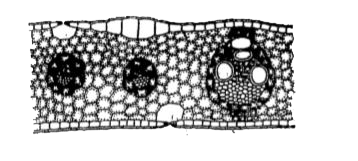Which of the following characters is/are related isobilateral leaf?
(a) Stomata are present on both surfaces.
(b) Mesophyll is differentiated into palisade and spongy parenchyma.
(c) Sub-stomatal cavity is present below the stoma of the abaxial epidermis.
Only ( a )
Only ( c )
Only ( a ) & ( c )
( a ), ( b ) & ( c )
The correct Answer is:B
Step by step video, text & image solution for Which of the following characters is/are related isobilateral leaf? (a) Stomata are present on both surfaces.(b) Mesophyll is differentiated into palisade and spongy parenchyma.(c) Sub-stomatal cavity is present below the stoma of the abaxial epidermis. by Biology experts to help you in doubts & scoring excellent marks in Class 12 exams.
Topper's Solved these Questions
Similar Questions
The epidermis of an isobilateral leaf,a)Provide protection,b)Performs gaseous exchange,c) Is made up of parenchymatous cells,d)Possesses stomata only on adaxial surface
View Solutionwhich of the following is not common for chloroplasts and Mitochondria?
(A) Both are present in all animal cells
(B) Both are present in autotrophic plant cells
(C) Both are present only in eukaryotes
(D) Both contain DNAView Solution
Knowledge Check
- Question 1 - Select One
Which of the following characters is/are related isobilateral leaf?
(a) Stomata are present on both surfaces.
(b) Mesophyll is differentiated into palisade and spongy parenchyma.
(c) Sub-stomatal cavity is present below the stoma of the abaxial epidermis.AOnly ( a )BOnly ( c )COnly ( a ) & ( c )D( a ), ( b ) & ( c ) - Question 2 - Select One
The vertical section of plant material shows the following anatomical characters under microscope :- Mesophyll is differentiated into palisade parenchyma and spongy parenchyma, bundle sheath extensions are parenchymatous and usually stomata are more on lower surface. Plant material should be -
ADicot stemBDorsiventral leafCIsobilateral leafDMonocot stem - Question 3 - Select One
Which of the following statements are not correct regarding this?

I. It is an isobilateral leaf.
II. The leaf shows reticulate venation.
III. The leaf may exhibit kranz anatomy.
IV. Such type of leaf may bë present in plants undergoing C4 pathway.
V. Mësophyll is differentiated into palisade and spongy parenchyma.
VI. Such type of leaf is found in hydrophytes.
VII. Such type of leaf is found in meņbers of Family Poaceae.AI, II and IVBI, III, IV and VIICII, V and VIDIII, V, VI and VII
Study the following statements regarding the anatomy of isobilateral leaf.
(i) Stomata are equally distributed on both the surfaces.
(ii) Certain adaxial epidermal cells are modified into bulliform cells in grasses.
(iii). The vascular bundles are radial
(iv). Phloem is adaxially placed.
Which of the above statements are correct?View SolutionWhich of the following type of tissure os characterized by the following statements?
A. It is present in the dry surface of the skin and the moist surface of buccal cavity .
B. Its main function is to provide resistance to mechanical and chemical stress.View SolutionA taxon is observed, which is a hybrid variety had twice the amount of amino acids, lysine and tryptophan. In this taxon bunch of silky hairs of inflorescence wave in the wind to trap pollen grains. Which of the following characters are related to the taxon ?
(A) Caryopsis fruit
(B) Bruce roots
(C) Monoecious nature
(D) Persistent endosperm in mature seed
(E) Conjoint and closed vascular bundles of similar size in both stem and leavesView SolutionWhich of the following cells are present only in the epidermis of Hydra?
(A) Interstitial cells
(B) Cnidoblasts
(C) Sensory cells
(D) Germ cellsView SolutionHow many of the following statements are related to bone?
a. It is a specialised connective tissue having hard and pliable ground substance rich in calcium salts and collagen fibres which gives bone its strength.
b. It is the main tissue that provides structural frame to the body.
c. It supports and protects softer tissues and organs.
d. The bone cells, osteocytes are present in the spaces called lacunae.
e. They also interact with smooth muscles attached to them to bring about movements.View Solution

